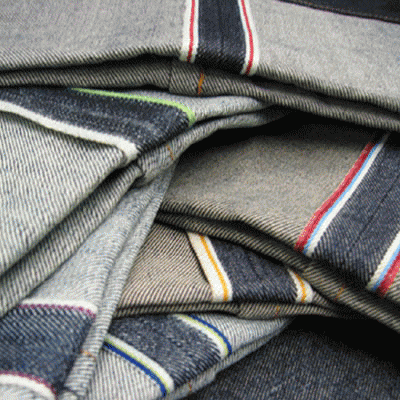
I grew up in a fabric-obsessed house. My mom dedicated a whole bedroom to an enormous pedal loom, and when we were broke, she’d trade scarves and shawls for haircuts. She doesn’t have a loom anymore, but she still buys and sells vintage fabric on the side. The sound of a clattering shuttle and the hand of a beautiful fabric are baked into my DNA.
The selvedge (or selvage) in “selvedge denim” is a question of weaving, but it’s also a question of symbolism. I’ll explain.
The Woven Difference
Let’s start with the technical. Fabric is woven by a loom. Shuttle looms, which were the standard until the mid-20th century, weave a relatively narrow length of fabric, with finished edges. The edges are called the selvedge. You can see them above – they’re the things with the colorful stripes.
Without a selvedge, a seam like the ones above would have to be finished with thread. Turn a t-shirt inside-out and you’ll see edges finished this way. The role of the finishing here is to prevent the weave from unraveling at the fabric’s edge.
The Loom Diaspora
Shuttle looms fell out of broad use in the years after World War II, when more efficient technologies were developed. These new projectile looms didn’t require a bulky shuttle and could produce much wider lengths of fabric. As demand for jeans (and in turn, denim) ramped up, it was met by these new, hyper-efficient machines. But: wide fabric lengths and superfast industrial machines mean that instead of using the woven edges that the old looms wove, fabric was cut and the edges bound with thread. That’s still how the fabric edges of most mass-market jeans are finished today.
As these new machines were introduced, the old machines were decommissioned, and the story goes that over the years, many found their way to Japan, where some had landed in the post World War reconstruction. (Whether that story’s true is a matter of debate.) In the 1980s, an artisinal denim movement, fueled by a passion for Americana, emerged in the far East, and in the 2000s, it found its way to the US. At the same time, America’s textile production was dwindling to nearly nothing.
Selvedge As Cultural Signifier
The selvedge became a cultural signifier. Japanese enthusiasts could turn their cuff slightly to show that they either had vintage jeans – made when the old looms were still in service – or they had new jeans made from fabric woven on old looms. In large part, that’s still what the selvedge means today. Sure, the selvedge edge is a little less likely to fray than the bound edge, but when was the last time the edge of the fabric in your jeans frayed?
When you pay for selvedge, you’re buying a symbolic message that you care, and a message from the manufacturer that they do, too. Here’s a parallel: traditionally, the bottom-most buttonhole of a shirt has been horizontally oriented. It maybe has some practical purpose, but mostly the presence of that horizontal buttonhole means: “I care,” for both wearer and manufacturer.
So Why Does It Matter?
These days, you can buy selvedge denim for $40 from Converse, $89 from The Gap or $350 from The Flat Head. The fabrics and details on these jeans are likely very different. The design choices and cut are different. The marketing is different. Almost everything, in other words, can be different.
The thing they share is that little colored stripe.